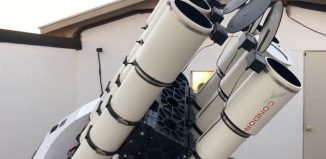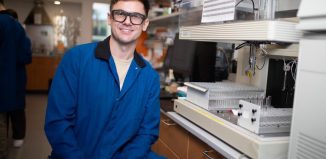Stony Brook team set the boron record straight
Human mistakes occur everywhere, from a driver who runs a red light to a professional athlete who literally drops a ball, to an accountant who adds the wrong numbers. Even scientists, with their lab coats, their scientific method and their careful review process make errors.
So it was, in 2013, when scientists in Switzerland published a research paper suggesting that boron could exhibit a similar behavior to a topological insulator. If true, that could have implications for nanotechnology.
Recently, however, postdoctoral student Xiang-Feng Zhou at Stony Brook University, working with his lab director Artem Oganov, discovered that their fellow researchers had made a mistake. The Swiss scientists had “suggested metallicity for boron’s surface and this turned out to be an incorrect suggestion,” said Oganov.
Typically, topological insulators are made up of heavier elements. The Swiss scientists believed that the surface atom rearrangements in boron would enable the lighter element to exhibit the same conducting properties.
Zhou was able to test this theory by using a high-powered computer system created by Oganov and his colleagues. Called USPEX, for Universal Structure Predictor: Evolutionary Xtallogaraphy, the prediction code uses a set of principals driven by quantum mechanics.
Zhou and Oganov, who is a professor of theoretical crystallography at Stony Brook University, published their results recently in the journal Physical Review Letters, a journal of the American Physical Society.
“Topological insulators must include heavy elements and metallicity of their surfaces does not come from structural reconstructions,” Oganov said. “For boron, a similar effect was predicted (as we now know, incorrectly) due to the reconstruction of the surface.”
The Swiss scientists knew that breaking a solid causes a cleaving of many bonds, Oganov said. Atoms near the surface try to compensate for the lost bonds. Often, this results in unusual chemistry, he continued. The Swiss scientists thought this would lead to metallicity, he said.
Using their computer model, Zhou and Oganov found that boron would have a much more stable structure if it avoided a metallic state. Instead, it forms a semiconducting surface.
When Zhou, who is also an associate professor of physics at Nankai University in Tianjin, China, and Oganov sent their results for publication, the editors at Physical Review Letters did what they always do: they sent the paper to several experts in the field for review. One of the groups overseeing the analysis of the Stony Brook scientists’ results was the original team from Switzerland. Oganov wasn’t sure how they’d react.
“Usually, people are upset when their results are disproven,” Oganov said. “They checked our calculations and found that our result is correct. They gracefully admitted a mistake. Often, people would fight even knowing they are wrong.”
The Swiss scientists said they didn’t find the right surface because they didn’t have enough computing power, Oganov said. They suggested to Oganov that they finished their calculations “too soon.”
Another reviewer confirmed the result was correct, while a third one suggested the result might not even be worth publishing because it was something a scientist might be able to come up with using a pencil and paper.
“I take this as a compliment,” said Oganov. “Simple and beautiful are sometimes hard to come by. Heavy computations like the ones we have done are often the best way to find the simple reality. Reality is not always simple.”
Oganov credits Zhou, whom he met over five years ago and recruited to join his lab on one of his annual trips to China, with pursuing this work.
What Zhou found was “absolutely surprising and unexpected. I couldn’t expect the Swiss paper would be so far from the solution. I give [Zhou] credit for his inquisitiveness. It is hard and beautiful work.” Zhou said he met Oganov when he was a Ph.D. student. He found that the two of them had similar interests. “I love predicting crystal structures,” Zhou said.
Oganov was born in the Ukraine and raised and educated in Russia. He has worked in the UK, Switzerland and the United States. While science has a discipline and approach that keeps researchers from making unsupported claims, scientists still make mistakes. “Nobody,” he offered, “is insured from making mistakes.”






